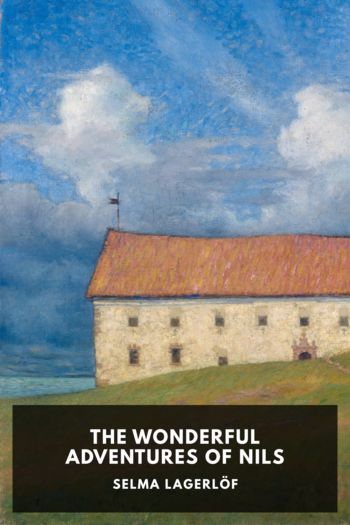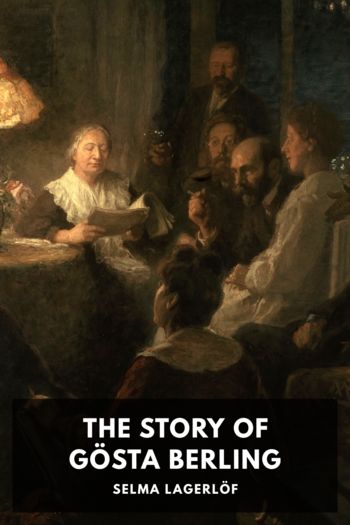The Wonderful Adventures of Nils by Selma Lagerlöf (i can read book club TXT) 📕

Description
In The Wonderful Adventures of Nils, Selma Lagerlöf tells the story of Nils Holgersson, a young boy who is transformed into an elf after a set of misdeeds. Escaping with his family’s farm goose he joins up with a flock of wild geese and travels with them across Sweden as they return to their annual nesting grounds in Lapland.
The story was originally written as a commission for the Swedish National Teachers’ Association to write a geography book for children and has become a firm favourite in the country. It’s been adapted for screen many times, translated into over 30 languages and, until recently, was the artwork on the 20 krona banknote.
Although originally published in English in two volumes—the second starting at “The Story of Karr and Grayskin”—here they are presented as a single combined story.
Read free book «The Wonderful Adventures of Nils by Selma Lagerlöf (i can read book club TXT) 📕» - read online or download for free at americanlibrarybooks.com
- Author: Selma Lagerlöf
Read book online «The Wonderful Adventures of Nils by Selma Lagerlöf (i can read book club TXT) 📕». Author - Selma Lagerlöf
In the middle of the courtyard stood a tiny creature, who blew upon a pipe. All round him he had a whole circle of rats who listened to him, astonished and fascinated; and every moment brought more. Once he took the pipe from his lips—only for a second—put his thumb to his nose and wiggled his fingers at the gray rats; and then it looked as if they wanted to throw themselves on him and bite him to death; but as soon as he blew on his pipe they were in his power.
When the tiny creature had played all the gray rats out of Glimminge castle, he began to wander slowly from the courtyard out on the highway; and all the gray rats followed him, because the tones from that pipe sounded so sweet to their ears that they could not resist them.
The tiny creature walked before them and charmed them along with him, on the road to Vallby. He led them into all sorts of crooks and turns and bends—on through hedges and down into ditches—and wherever he went they had to follow. He blew continuously on his pipe, which appeared to be made from an animal’s horn, although the horn was so small that, in our days, there were no animals from whose foreheads it could have been broken. No one knew, either, who had made it. Flammea, the steeple-owl, had found it in a niche, in Lund cathedral. She had shown it to Bataki, the raven; and they had both figured out that this was the kind of horn that was used in former times by those who wished to gain power over rats and mice. But the raven was Akka’s friend; and it was from him she had learned that Flammea owned a treasure like this. And it was true that the rats could not resist the pipe. The boy walked before them and played as long as the starlight lasted—and all the while they followed him. He played at daybreak; he played at sunrise; and the whole time the entire procession of gray rats followed him, and were enticed farther and farther away from the big grain loft at Glimminge castle.
The Great Crane Dance on KullabergTuesday, March twenty-ninth.
Although there are many magnificent buildings in Skåne, it must be acknowledged that there’s not one among them that has such pretty walls as old Kullaberg.
Kullaberg is low and rather long. It is not by any means a big or imposing mountain. On its broad summit you’ll find woods and grain fields, and one and another heather-heath. Here and there, round heather-knolls and barren cliffs rise up. It is not especially pretty up there. It looks a good deal like all the other upland places in Skåne.
He who walks along the path which runs across the middle of the mountain, can’t help feeling a little disappointed. Then he happens, perhaps, to turn away from the path, and wanders off toward the mountain’s sides and looks down over the bluffs; and then, all at once, he will discover so much that is worth seeing, he hardly knows how he’ll find time to take in the whole of it. For it happens that Kullaberg does not stand on the land, with plains and valleys around it, like other mountains; but it has plunged into the sea, as far out as it could get. Not even the tiniest strip of land lies below the mountain to protect it against the breakers; but these reach all the way up to the mountain walls, and can polish and mould them to suit themselves. This is why the walls stand there as richly ornamented as the sea and its helpmeet, the wind, have been able to effect. You’ll find steep ravines that are deeply chiselled in the mountain’s sides; and black crags that have become smooth and shiny under the constant lashing of the winds. There are solitary rock-columns that spring right up out of the water, and dark grottoes with narrow entrances. There are barren, perpendicular precipices, and soft, leaf-clad inclines. There are small points, and small inlets, and small rolling stones that are rattlingly washed up and down with every dashing breaker. There are majestic cliff-arches that project over the water. There are sharp stones that are constantly sprayed by a white foam; and others that mirror themselves in unchangeable dark-green still water. There are giant troll-caverns shaped in the rock, and great crevices that lure the wanderer to venture into the mountain’s depths—all the way to Kullman’s Hollow.
And over and around all these cliffs and rocks crawl entangled tendrils and weeds. Trees grow there also, but the wind’s power is so great that trees have to transform themselves into clinging vines, that they may get a firm hold on the steep precipices. The oaks creep along on the ground, while their foliage hangs over them like a low ceiling; and long-limbed beeches stand in the ravines like great leaf-tents.
These remarkable mountain walls, with the blue sea beneath them, and the clear penetrating air above them, is what makes Kullaberg so dear to the people that great crowds of them haunt the place every day as long as the summer lasts. But it is more difficult to tell what it is that makes it so attractive to animals, that every year they gather there for a





Comments (0)